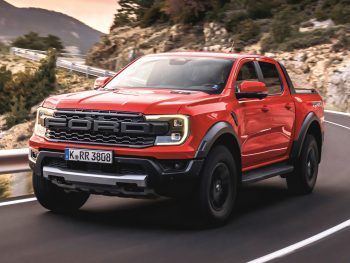The new Ford Ranger is here at long last – and worth the wait, thinks George Barrow.
 It’s been a while since a pick-up truck has been launched with a big engine, the last one being the ill-fated Mercedes-Benz X-Class back in 2018. And it has been even longer since one was available with a petrol engine.
It’s been a while since a pick-up truck has been launched with a big engine, the last one being the ill-fated Mercedes-Benz X-Class back in 2018. And it has been even longer since one was available with a petrol engine.
But the second-generation Ford Ranger Raptor is changigng all that, with a new 3.0-litre V6 turbocharged petrol engine. The EcoBoost V6 produces 289hp with 491Nm of torque and gives the Raptor a flagship powertrain it can finally shout about. Lower-powered models will also be available.
As with the previous Raptor, power is delivered through the same 10-speed transmission, but it has been reprogrammed with unique turbocharging boost profiles depending on the gear. That means that no matter which gear you’re in, the Raptor is ready to give you maximum boost when you floor the accelerator. In addition to the V6 engine, the Raptor also has an adaptive exhaust note system.
The suspension is once again the main engineering highlight of the Raptor with new Fox 2.5-inch Live Valves that stiffen up at the lower end of their travel to allow the Raptor to absorb massive levels of abuse.
The new suspension has also improved the handling and with the dampers now positioned away from the frame and an increased steering ratio, the Raptor is even more direct when turning in and far quicker to respond. It’s a benefit felt across all terrains, but is especially noticeable on the road where the Raptor has become effortless to drive quickly.
Mechanically, the Ranger Raptor has had several formidable upgrades to make it even more capable off-road. These include a 20mm increase in front suspension travel for the front axle giving it 256mm of travel and 290mm at the rear. But it is the addition of a front locking differential as standard, as well as the locking rear, that really aids its performance. On top of the mechanical improvements there are new and revised driveline settings (selectable through a rotary dial on the transmission tunnel) that include Normal, Sport and Slippery settings for the road as well as four off-road functions: Rock Crawl, Sand, Mud/Ruts and Baja.
Another intelligent off-road system is the new Trail Control. A sort of off-road cruise control that works from 1mph up to 20mph. It works brilliantly, taking care of the power while you can concentrate on the steering and works on all terrain types including when going downhill.
There’s so much to like about the new Ranger Raptor from the new C-shape daytime running lights that mimic the Ford F150’s appearance through to the very noticeable ‘Ranger’ stamped on the tailgate, but the combination of a halo engine that not only sounds great and performs well with all the new suspension, handling and off-road system changes makes the Raptor the most capable and complete pick-up in the market.
The downside is that the Raptor weighs 2,454kg and therefore only has a payload of 652kg, making it ineligible for a VAT refund for commercial use. In the eyes of the tax man, it is a passenger car, and with a luxury interior that includes a 12-inch portrait touchscreen, not to mention its £57,960 on the road price, Raptor buyers will likely be thinking of it as such as well.
IN BRIEF
WHAT IS IT? Double cab pickup
HOW MUCH? £57,960 OTR
GROSS PAYLOAD? 652kg
ECONOMY? 20.5mpg (WLTP)
DRIVE? 3.0-litre twin turbocharged petrol. 289hp @ 5,500rpm / 491Nm @ 2,300rpm
VERDICT
Purely as an on-road pick-up truck, the Ranger Raptor is probably hard to justify the expense, but if some robust off-roading is occasionally needed then the Raptor is easily worth the money.

